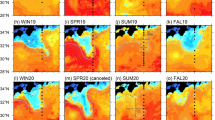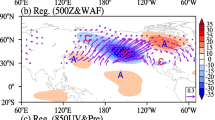Abstract
Based on a variety of ground-based and satellite-derived observational data, we studied a flood-rainstorm event that occurred over northeastern Sichuan, China, from the 8th to the 14th of September 2014. Four periods of mesoscale convective system (MCS) activity were found during a mutual evolution process of an 850-hPa basin inverted trough (BIT) and 850-hPa basin low vortex (BLV). Among them, the first three periods occurred in an alternating evolution of the BIT and BLV (called the first stage), and then, the fourth period was stimulated by continuous activity of the BLV (called the second stage). During the first stage, MCSs enhanced (weakened) under the situation of the BIT (BLV), and then during the second stage MCSs developed to their strongest levels. Further analysis of the reasons behind the enhancement and weakening of MCSs revealed an obvious characteristic of upper level (lower level) positive (negative) divergence in the BIT situation of the first stage and BLV situation of the second stage. By comparison, under the BLV situation of the first stage, the vertical helicity was larger in the upward airflow of the zonal circulation, and the direction of the wet Q-vector was toward the ascending airflow in the vertical direction. In the horizontal direction, the negative divergence of the wet Q-vector corresponded to the position of water vapor flux convergence. In addition, in the early development of convection, sounding data showed a humidity profile of dry upper and wet lower levels, as well as a larger value of convective available potential energy, which triggered convective activity under the favorable dynamic conditions of atmosphere. When the above characteristics weakened, the convective activity also weakened. Therefore, the formation of multiple convective systems was closely related to the adjustment in atmospheric conditions around the BIT and BLV.














Similar content being viewed by others
References
Bei NF, Zhao SX, Gao ST (2002) Numerical simulation of a heavy rainfall event in China during July 1998. Meteorol Atmos Phys 80(1–4):153–164. https://doi.org/10.1007/s007030200022
Chen YR, Li YQ (2013) Characteristics of mesoscale convective system and its effects on short-time severe rainfall in Sichuan Basin during 21–22 July 2012. Meteorol Mon 39(7):848–860. https://doi.org/10.7519/j.issn.1000-0526.2013.07.006 (in Chinese)
Chen LS, Luo ZX (2003) A preliminary study of the dynamics of eastward shifting cyclonic vortices. Adv Atmos Sci 20:323–332. https://doi.org/10.1007/BF02690790
Chen YR, Li YQ, Zhao TL (2015) Cause analysis on eastward movement of Southwest China vortex and its induced heavy rainfall in South China. Adv Meteorol. https://doi.org/10.1155/2015/481735
Cheng MH, He HZ, Mao DY, Qi YJ, Cui ZH, Zhou FX (2001) Study of 1998 heavy rainfall over the Yangtze River Basin using TRMM data. Adv Atmos Sci 18(3):387–396. https://doi.org/10.1007/BF02919317
Cheng XL, Li YQ, Li Xu (2016) An analysis of an extreme rainstorm caused by the interaction of the Tibetan Plateau vortex and the Southwest China vortex from an intensive observation. Meteorol Atmos Phys 128(3):373–399. https://doi.org/10.1007/s00703-015-0420-2
Davis-Jones R (1991) The frontogenetical forcing of secondary circulations part I: the duality and generalization of the Q vector. J Atmos Sci. 48(4):497–509. https://doi.org/10.1175/1520-0469(1991)048<0497:TFFOSC>2.0.CO;2
Duan AM, Sun RZ, He JH (2017) Impact of surface sensible heating over the Tibetan Plateau on the western Pacific subtropical high: a land–air–sea interaction perspective. Adv Atmos Sci 34(2):157–168. https://doi.org/10.1007/s00376-016-6008-z
Feng XY, Liu CH, Fang GZ, Liu XD, Fang CY (2016) Climatology and structures of southwest vortices in the NCEP climate forecast system reanalysis. J Climate 29(21):7675–7701. https://doi.org/10.1175/JCLI-D-15-0813.1
Fu SM, Sun JH, Zhao SX, Li W (2011) The energy budget of a southwest vortex with heavy rainfall over South China. Adv Atmos Sci 28(3):709–724. https://doi.org/10.1007/s00376-010-0026-z
He ZW, Zhang QH, Sun J (2016) The contribution of mesoscale convective systems to intense hourly precipitation events during the warm seasons over central East China. Adv Atmos Sci 33(11):1233–1239. https://doi.org/10.1007/s00376-016-6034-x
Hoskings BJ, Dragchici I, Davies HC (1978) A new look at ω-equation. Q J R Meteorol Soc 104:31–38. https://doi.org/10.1002/qj.49710443903
Kuo YH, Cheng LS, Anthes RA (1986) Mesoscale analyses of the Sichuan flood catastrophe, 11–15 July 1981. Mon Weather Rev. 114(11):1984–2003. https://doi.org/10.1175/1520-0493(1986)114<1984:MAOTSF>2.0.CO;2
Kuo YH, Cheng LS, Bao JW (1988) Numerical simulation of the 1981 Sihuan flood. part I: evolution of a mesoscale southwest vortex. Mon Weather Rev. 116(12):2481–2504
Li GP, Deng J (2013) Atmospheric water monitoring by using ground-based GPS during heavy rains produced by TPV and SWV. Adv Meteorol. https://doi.org/10.1155/2013/793957
Li YQ, Gao WL (2007) Atmospheric boundary layer circulation on the eastern of Tibetan Plateau, China, in summer. Arct Antarct Alp Res 39(4):708–713
Li L, Zhang RH, Wen M (2011) Diagnostic analysis of the evolution mechanism for a vortex over the Tibetan Plateau in June 2008. Adv Atmos Sci 28(4):797–808. https://doi.org/10.1007/s00376-010-0027-y
Li L, Zhang RH, Wen M (2014a) Diurnal variation in the occurrence frequency of the Tibetan Plateau vortices. Meteorol Atmos Phys 125:135–144. https://doi.org/10.1007/s00703-014-0325-5
Li L, Zhang RH, Wen M et al (2014b) Effect of the atmospheric heat source on the development and eastward movement of the Tibetan Plateau vortices. Tellus A. https://doi.org/10.3402/tellusa.v66.24451
Li J, Du J, Zhang DL, Cui CG, Liao YS (2014c) Ensemble-based analysis and sensitivity of mesoscale forecasts of a vortex over southwest China. Q J R Meteorol Soc 140:766–782. https://doi.org/10.1002/qj.2200
Li YQ, Yu L, Chen BD (2015) An Assessment of design of observation network over the Tibetan Plateau based on observing system simulation experiments (OSSE). J Meteorol Soc Jpn 93(3):343–358. https://doi.org/10.2151/jmsj.2015-019
Lilly DK (1986) The structure and propagation of rotation convective storm. Part 2: helicity and storm. J Atmos Sci. 43(2):126–140. https://doi.org/10.1175/1520-0469(1986)043<0126:TSEAPO>2.0.CO;2
Lin ZQ (2015) Analysis of Tibetan Plateau vortex activities using ERA-Interim data for the period 1979–2013. J Meteorol Res 29(5):720–734. https://doi.org/10.1007/s13351-015-4273-x
Lu JH (1986) Generality of the southwest vortex. China Meteorological Press, Beijing, pp 1–270 (in Chinese)
Lu HJ, Gao ST (2003) On the helicity and the helicity equation. Acta Meteorol Sin 61(6):684–691. https://doi.org/10.11676/qxxb2003.069 (in Chinese)
Ni CC, Li GP, Xiong XZ (2017) Analysis of a vortex precipitation event over Southwest China using AIRS and in situ measurements. Adv Atmos Sci 34(4):559–570. https://doi.org/10.1007/s00376-016-5262-4
Schumacher RS, Johnson RH (2005) Organization and environmental properties of extreme-rain-producing mesoscale convective systems. Mon Weather Rev 133:961–976. https://doi.org/10.1175/MWR2899.1
Schumacher RS, Johnson RH (2008) Mesoscale processes contributing to extreme rainfall in a midlatitude warm-season flash flood. Mon Weather Rev 136:3964–3986. https://doi.org/10.1175/2008MWR2471.1
Shen RJ, Reiter ER, Bresch JF (1986) Numerical simulation of the development of vortices over the Qinghai-Xizang Plateau. Meteorol Atmos Phys 35(1–2):70–95. https://doi.org/10.1007/BF01029526
Sun JH, Zhao SX, Xu GK, Meng QT (2010) Study on a mesoscale convective vortex causing heavy rainfall during the Mei-yu season in 2003. Adv Atmos Sci 27(5):1193–1209. https://doi.org/10.1007/s00376-009-9156-6
Tao SY, Ding YH (1981) Observational evidence of the influence of the Qinghai-Xizang (Tibet) Plateau on the occurrence of heavy rain and severe convective storms in China. Bull Am Meteorol Soc. 62:23–30. https://doi.org/10.1175/1520-0477(1981)062<0023:OEOTIO>2.0.CO;2
Wang B (1987) The development mechanism for Tibetan Plateau warm vortices. J Atmos Sci. 44:2978–2994. https://doi.org/10.1175/1520-0469(1987)044<2978:TDMFTP>2.0.CO;2
Wang Z, Gao K (2003) Sensitivity experiments of an eastward-moving southwest vortex to initial perturbations. Adv Atmos Sci 20(4):638–649. https://doi.org/10.1007/BF02915507
Wang B, Orlanski I (1987) Study of a heavy rain vortex formed over the eastern flank of the Tibetan Plateau. Mon Weather Rev. 115(7):1370–1393. https://doi.org/10.1175/1520-0493(1987)115<1370:SOAHRV>2.0.CO;2
Wang QW, Tan ZM (2014) Multi-scale topographic control of southwest vortex formation in Tibetan Plateau region in an idealized simulation. J Geophys Res 119(20):11543–11561. https://doi.org/10.1002/2014JD021898
Wu GX, Chen SJ (1985) The effect of mechanical forcing on the formation of a mesoscal vortex. Q J R Meteorol Soc 111:1049–1070. https://doi.org/10.1002/qj.49711147009
Xiang SY, Li YQ, Li D, Yang S (2013) An analysis of heavy precipitation caused by a retracing plateau vortex based on TRMM data. Meteorol Atmos Phys 122:33–45. https://doi.org/10.1007/s00703-013-0269-1
Yu SH, Gao WL (2009) Large-scale conditions of Tibet Plateau vortex departure. Sci Cold Arid Reg 1:559–569
Yu SH, Gao WL, Peng J, Xiao YH (2014) Observational facts of sustained departure plateau vortexes. J Meteorol Res 28(2):296–307. https://doi.org/10.1007/s13351-014-3023-9
Yu SH, Gao WL, Xiao DX, Peng J (2016) Observational facts regarding the joint activities of the southwest vortex and plateau vortex after its departure from the Tibetan Plateau. Adv Atmos Sci 33(1):34–46. https://doi.org/10.1007/s00376-015-5039-1
Yue CJ, Shou SW (2008) A modified moist ageostrophic Q vector. Adv Atmos Sci 25(6):1053–1061. https://doi.org/10.1007/s00376-008-1053-x
Yue CJ, Shou SW, Lin KP, Yao XP (2003) Diagnosis of the heavy rain near a Mei-yu front using the wet Q vector partitioning method. Adv Atmos Sci 20(1):37–44. https://doi.org/10.1007/BF03342048
Yue CJ, Gao ST, Liu L, Li XF (2015) A diagnostic study of the asymmetric distribution of rainfall during the landfall of typhoon Haitang (2005). Adv Atmos Sci 32(10):1419–1430. https://doi.org/10.1007/s00376-015-4246-0
Zhang XW (1998) An expression of the wet Q vector and application. Meteorol Mon 24(8):3–7 (in Chinese)
Acknowledgements
This work was supported by a key project of the National Natural Science Foundation of China (No. 91337215). We are grateful to the strong convection forecasting team at the CMA for the assistance which they provided.
Author information
Authors and Affiliations
Corresponding author
Additional information
Responsible Editor: M. Telisman Prtenjak.
Rights and permissions
About this article
Cite this article
Chen, Y., Li, Y. & Qi, D. Analysis of the convective characteristics during the mutual evolution of an inverted trough/low vortex and its induced rainstorm over the northeastern Sichuan basin, China. Meteorol Atmos Phys 131, 807–825 (2019). https://doi.org/10.1007/s00703-018-0607-4
Received:
Accepted:
Published:
Issue Date:
DOI: https://doi.org/10.1007/s00703-018-0607-4




